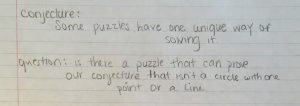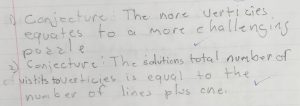Your assignment for the next week is to try to prove the conjecture that your group created in class on Tuesday, 10/12/15. You may need to refine/expand your conjecture first (let’s discuss this in class). You must spend at least 90 minutes working on this. Trying to prove something can consist of many different activities, such as the following (you do NOT have to do all of these things – you can choose how to spend your time – they are provided for inspiration only).
- coming up with ideas, and testing them out (for example, by creating puzzles and trying to solve them)
- trying to understand what the conjecture says
- trying to solve puzzles that other people created
- trying to create puzzles (and solve them yourself)
- communicating with other members of your group (talking, emailing, etc.)
- trying to write down a proof
- other stuff…
As you work, keep track of what you are doing, thinking, and feeling (this is metacognition – an idea that discussed way back in OpenLab #2). What did you do during the time you spent? Did you create any puzzles? Did you solve puzzles? Did you change your mind about whether the conjecture is true or false? Did you have any new ideas about how to prove the conjecture? Did you have any ideas that you gave up on? How did you feel as you worked – were you frustrated/confused/happy/depressed? Why? Did your mood change along the way?
Assignment (Due Thursday, 11/2/15): Submit a journal of your efforts in the comments below. Your response should be at least 300 words. Describe what you did during the 90 minutes you worked, and express in some way what you were thinking and feeling during the process. Your response can include puzzles (use sketchtoy.com) or other work you did along the way.
Extra Credit. Respond to a fellow student’s comment. Did you do similar things? Different things? Do you have any suggestions for them? Be kind.
GROUP CONJECTURES (Updated in class 10/24):
GROUP 1: Neil, Kelly, (Zaniya)
GROUP 2: Stephanie, Yasmine, Ahmad, Syed
GROUP 3: Evelin, Josvenia, Sonam, Miralia
GROUP CONJECTURES (Original):
GROUP 1: Neil, Kelly, (Zaniya)
GROUP 2: Stephanie, Yasmine, Ahmad, (Syed)
GROUP 3: Evelin, Josvenia, Sonam, Miralia









“Some puzzles have only one unique solution” This is the conjecture come up with our group member Evelin, and we chose it as our group conjecture. After we made our decision for our conjecture, we started to try to find a puzzle that proves our conjecture. At the beginning, we had some difficulties to find a puzzle that only has one unique solution. We tried the puzzle that was given in the our OpenLab Assignment #4, also we create many our own puzzles. we find out that all the puzzle we got, if it is passible to solve, then they have 2 or more solutions. Because you can choose a different point to start or a different line to cross.
We used about 15 – 20 minute, we draw many puzzles. We discovered that in order for us to come up with a puzzle that has only one unique solution, we must limit our choices of point to start with or lines to cross. So, we said how about if we drew a puzzle, that this puzzle has only one line with two point at end of that line. After we draw that line, we found our first puzzle that proves our conjecture which is two point connected with one line. Then we add many points on that line, it we got that it still has only one solution, because you can not start at any points that not end point of the line, So we conclude that if a puzzle has only one line, then this puzzle has only one solution.
Since if a puzzle has only one line then, it has only one solution. We thought we should try if a puzzle has only one point. So, we draw a circle, and on that circle we marked one point. We find out that you always have to come back to that point. Thus, we considered that this puzzle also proves our conjecture. Also we conclude that if a puzzle is just one point, then that puzzle has only one unique solution.
With all the work we did, the goal of our group is finding a pattern or a rule that is always true for a puzzle that this puzzle has only one solution. We are not satisfied with what we leaned so far. and, we will continue working and reach our goal at the end.
My group’s original conjectures states that, “just because a puzzle has a solution, it does not mean that any starting point will result in a solution.” As me and my partners work on solving this diagram with 5 vertices and 8 edges. We realize that the starting point only works for those vertices who have degree 3. Which was only two vertices out of 5 vertices. The other 3 vertices have even degrees. As a group, we began to wonder what makes a point to be a starting point. We asked ourselves a question, “what are the requirements for a point to work as a starting point?”. As I spend an hour, drawing diagrams with vertices and edges that are enclosed. This is what I think: I started to realize that it doesn’t matter if you have even or odd lines, or, if you have even or odd vertices. But you still can have a starting point if both lines and vertices are even, or both lines and vertices are odd. I came up with some suggesting to what requirement can be place as to what makes it a starting point. These ideas may help me and my group prove both our question and conjecture.
Number one: if you have an even number of lines and vertices, your degrees must also be an even number, meaning all vertices.
Number two: if you have both odd numbers of vertices and edges, then your starting point must have a degree of an odd number.
Number 3: if you were to have an even number of lines and odd number of vertices then your starting point must have a degree of an odd number but only two vertices are going to be your starting point. And if you were to have an odd number of lines and even numbers of vertices then your starting point must have a degree of an odd number, and again, just two vertices will be your starting points.
To me, this was a bit confusing, especially trying to come up with diagrams that are both even numbers of vertices and edge. I almost gave up when I drew a diagram that have 14 lines and 8 vertices because I saw that 4 vertices are odd numbers, but there was no way to solve this diagram in any point.
I can’t wait to see what my group have to say about our conjecture and question. We are still trying to figure out how to solve this and create requirement that works for all close diagram, so we could be able to prove this.
Hi Stephanie,
As you stated, I think it does not matter if you have even or odd number of bridges or vertices. I think what matters is the number of bridges connected to a vertex. In other words, each vertex has to have an even number of bridges that are connected to it.
For the 90 minutes, I attempted to make a chart of the different number of bridges and islands. The reason why I said attempted was because I thought I was getting somewhere with the different combinations but little did I know I was back to square one. Well it wasn’t all a failure, I did notice some things from creating different puzzles. My chart consisted of four different columns; number of islands, number of bridges, possible or not possible, and how many ways. On a separate sheet of paper, I created the different puzzles depending on the number of islands and the number of bridges. For example, if I was working only with five islands then I would create puzzles only with five islands but with different number of bridges. I also set some rules for myself when I was trying to analyze if the puzzle was possible to solve or not. The rules were that an island must have at least one bridge connected to it, bridges cannot connect with each other unless there is an island in between them, and different solutions are counted only if the starting point and/or ending point is different. Everything was running smoothly, I thought I was developing a pattern. At first I thought that if the number of bridges was higher than the number of islands then we can assume that the possible will not be possible to solve. But I decided to go back to the beginning and recreate different puzzles for each row. After creating new puzzles, I realized that some of the new puzzles change my original solutions. Some of them went from impossible to possible and vice versa. So the pattern I thought I was developing quickly crumbled. It was frustrating to have to change my original conclusions but I’m trying to be optimistic about it. Hopefully my work will be useful in proving our conjecture.
Hi Evelin,
I can relate to what you did. I also went back, creating new puzzle to try to solve my group conjecture. It is pretty frustrating because I would end up in a dead end. May be come up with requirement to go with your conjecture, it might help.
Creating puzzles are really fun to do, but to solve some of them is not an easy thing to do. I realize that when our group tried to come up with the answer for our conjecture that there exists some puzzle that have one unique solution. In class we tried to figure it out by taking different examples however those example is not really satisfied. Therefore, we are trying to find which puzzle that has one unique solution beside a line or a circle. Then we find that a puzzle that start with a point if we can go back to that point than this puzzle has more than one solution. Hence, we can start from different point and still come up with the same result. With this idea I realize that in order to have a puzzle with one unique solution beside circle or a line the puzzle cannot connect all together some might combine but not all of them because if that case happen whether we will have many different solutions or the puzzle might be impossible. Then as I was thinking deeper I find that if a conjecture has many different point that are connect together but the starting point is not connected to that point the puzzle will have one unique solution.
At the beginning of working in groups my conjecture was that if we have vertex that is connected to more than two bridges that makes the puzzle impossible. However, Ahmed disproved this conjecture by creating a puzzle that has vertex connecting three bridges and made it possible. Then we tried our original new conjecture that suggested, if you we have a possible puzzle it is not necessary that every starting point can lead to a solution. Then, we wondered if we have a puzzle that can have solution using any starting point. After trying many times, we got a puzzle that have solution using any starting point and another that has solution but using specific starting point not any. Then we wonder why some possible puzzles can have solution using any point while other possible puzzles have solution using some points but not the others as starting point. In other words, our question was “what are the requirements for a point to work as starting point?”
Then, Syed suggested that the starting point that works might have to connect even number of bridges in order to be starting point that lead to a solution. Stephanie and me tried this in class and also I spend about 90 minutes at home to prove that and I think it works. Whenever I had no solution from a point, I realized there is a point that is connected to odd number of bridges. I think my next question is “why this is working with even number but not odd number?” I hope we can have an answer for this question. Sometimes I give up solving puzzle if I have a lot of other homework to do but It is interesting to solve puzzle and have some different properties when solving them specially if we work in group and exchange ideas.
I believe that in a puzzle, among all the vertexes, If the numbers of vertexes that connected with add number bridges is 0 or 2, then the puzzle is possible. But so far I don’t know why?. Let me know if you find a puzzle that can disprove my conjecture or if you can find the the reason the conjecture is true.
Our conjecture is that for some puzzles there is only one way specific way to asnwer.
first we started off by trying to find a puzzle that proved our conjecture. We used class time to find puzzles that proved our conjecture. We found a couple of puzzles that prove our conjecture, which is a line, a circle with one point, or a puzzle that can become a line like an S or a V.
Our question for our conjecture was if there was a puzzle that isn’t a line or a circle that can be solved one way. Each one of us took our turns presenting to each other puzzles we were coming up with. One Saturday afternoon I started thinking about this question and I started looking ideas of puzzles that would work. Two of 3 puzzles that I came up with worked.
We shared our ideas by whats app which I think was great because we were able to see if it actually worked or if the puzzle didn’t work. Sending pictures to each other helped each one of us understand how our conjecture worked and come up with idea of what makes our conjecture work and also how to answer our question.
One point we did agree on was that if you start with a point and can only go back to that point than you have more than the puzzle has more than one solution. So it is important to find puzzles that has points that can only passed on to once. This also means that we are no longer talking about bridges but also points and these points are important for the bridges and for our conjecture.